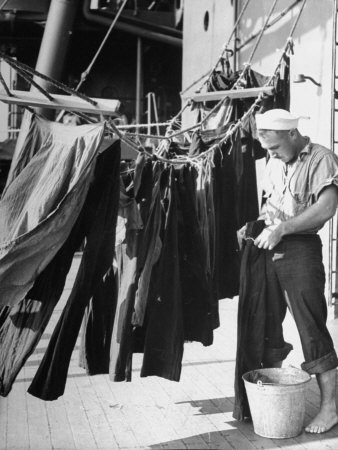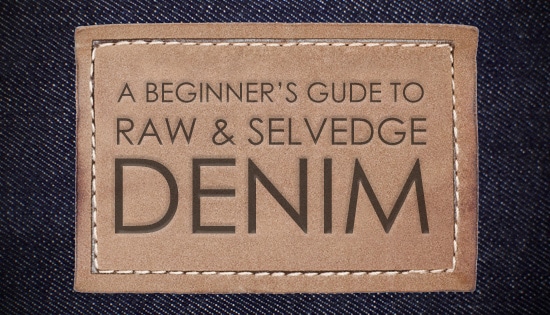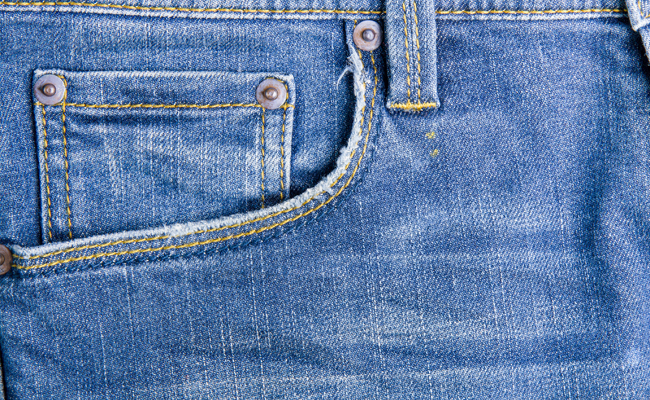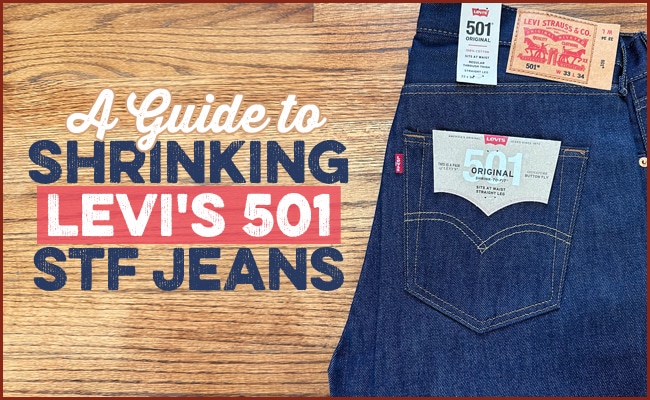
I wouldn’t call myself a denim-head, but I do appreciate a quality pair of jeans.
A type of jeans that I’ve experimented with in the past is raw denim jeans.
What’s raw denim?
Most denim jeans you buy today have been pre-washed and treated with a process called “sanforization” to soften up the fabric, reduce shrinkage, and prevent indigo dye from rubbing off. Raw denim (sometimes called “dry denim”) jeans are simply jeans made from denim that hasn’t gone through this prewash/treatment process.
The big selling point of raw denim jeans is that they start their life as a blank canvas that becomes personalized to you. While mass-produced jeans come with faux fading and distressing that is the same for every single pair, with raw denim, the fading and distressing are created by your body type and how you wear them. Also, the fit of raw denim becomes tailored to your body. Each pair ends up being uniquely yours, with a more custom look and feel.
If you want to try out raw denim jeans without breaking the bank, Levi’s 501 Shrink-to-Fit (STF) jeans can’t be beat. (Note: I don’t have any affiliation with Levis, nor is this a sponsored post.) They’re an American classic (your grandpa probably owned a pair of Levi’s 501s), they only cost $50 on Amazon, and they’ll last you a long time.
Because 501 Shrink-to-Fit jeans haven’t been pre-washed, you have to go through a special sizing and shrinking process to end up with the right fit.
Levi’s provides some guidelines on how to go about this process. I followed them with mixed results.
Below, I share what those results were and the tips I gleaned from my experiment in shrinking Levi’s 501 STF jeans.
How to Size Your Levi’s 501 Shrink-to-Fit Jeans
The key to getting the right fit with Levi’s 501 Shrink-to-Fit jeans lies in understanding the sizing process and accounting for the shrinkage that will occur. The size you choose will depend on the shrinking process you plan to use. Levi’s provides the following option-dependent guidelines:
- For the old-school technique, buy true to size in the waist and two sizes up in length. Wear them in the tub and keep them on to dry.
- For those who want to machine wash and dry the jeans, we recommend ordering up. For your waist, increase 1″ for sizes 27″-36″, 2″ for 38″-48″, and 3″ for 50″ and up. And for your inseam, increase 3″ for sizes 27″-34″ and 4″ for 36″ and up.
- For purists who like their denim unwashed, no need to size up. Buy them true to size.
To figure out which sizing/shrinking method provided the best results, I tried all three methods. Below are the results.
The Old-School Shrink-to-Fit Method
The old-school shrink-to-fit method requires you to buy 501s that are true to size in the waist and two sizes up in length. You then wear them in the tub and leave them on to dry.
I usually wear 33×32 in jeans, so this method required me to purchase 501s that are 33×34.
Instead of simply wearing the jeans in the tub, I opted for a more involved process that I’ve seen on other menswear sites that people claimed provided equal results without having to wear soaking wet jeans and drip indigo dye around the house. Here’s a step-by-step guide:
Step 1: Soak the Jeans
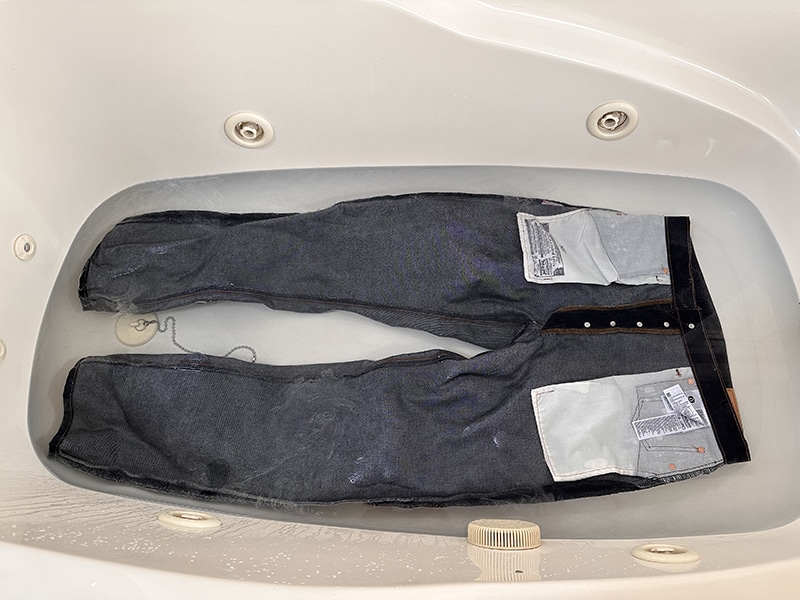
Fill your bathtub up with hot water. Turn the jeans inside out to minimize the amount of indigo dye lost during the soaking process. Place the jeans in the tub, ensuring the hot water fully covers them. Allow the jeans to soak for approximately 45 minutes to an hour.

The indigo dye that came off during the soak.
Step 2: Hang Dry
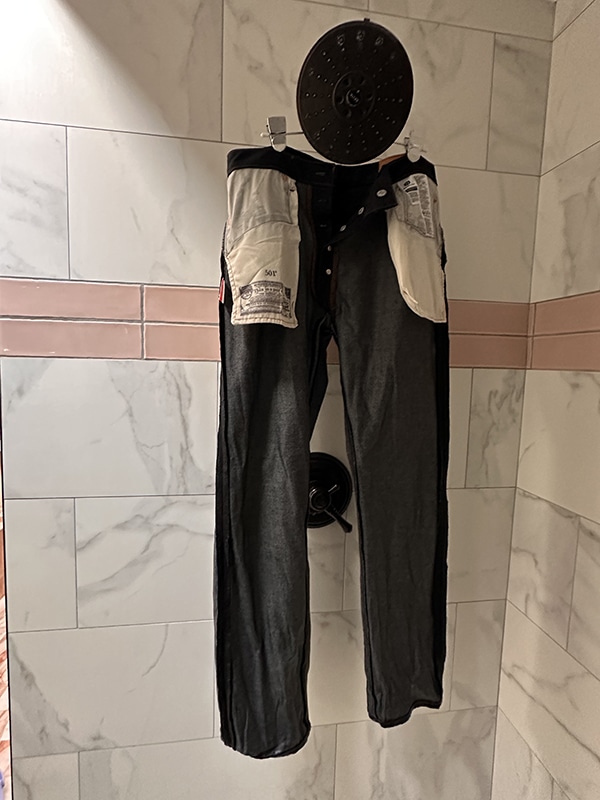
Remove the jeans from the tub and hang them up in the shower. Let them hang until they’re no longer dripping with water.
Step 3: Towel Dry
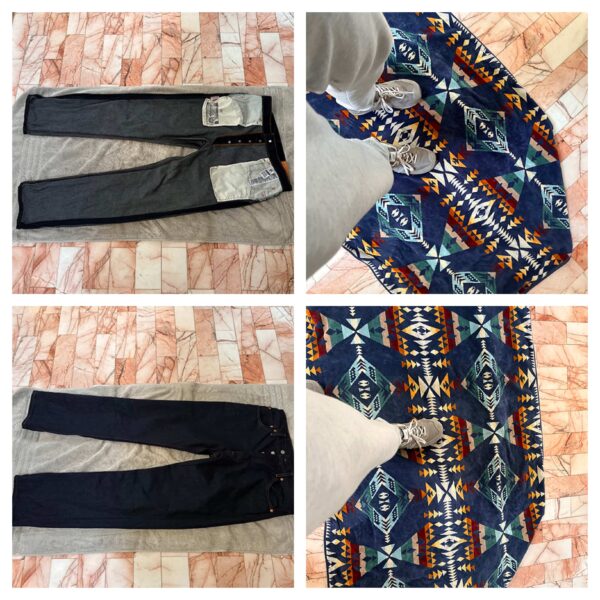
Once your jeans have drip-dried, place them horizontally on the floor between two towels. Step on the towel-covered jeans to extract as much water as you can. Flip the jeans right side out and repeat stepping on the towels.
Step 4: Wear Your Damp Jeans
While the jeans are still damp, it’s time to put them on and let them dry on your body. As the jeans dry, they will shrink and conform to your body shape, resulting in a fit that is unique to you. I recommend going commando while wearing your damp jeans. Your body heat will help speed up the drying process. Also, I’d avoid doing this in the winter, lest you freeze your bits.
Make sure to avoid sitting on any light-colored upholstery during this time, as there’s a chance you’ll get some indigo rub-off on it.
Old-School Tub Method Results
Here’s what my 33×34 501s looked like before going through the old-school shrink-to-fit process:
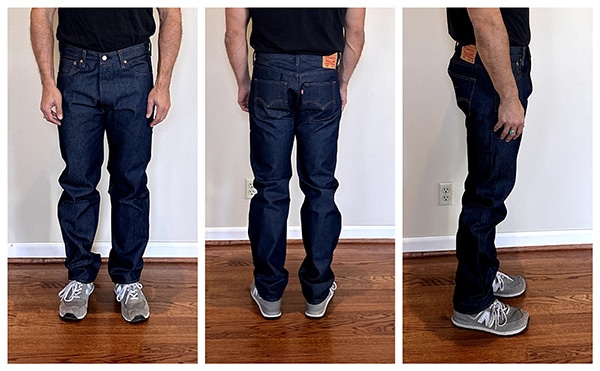
Before
Here’s what they looked like after going through the old-school shrink-to-fit process:
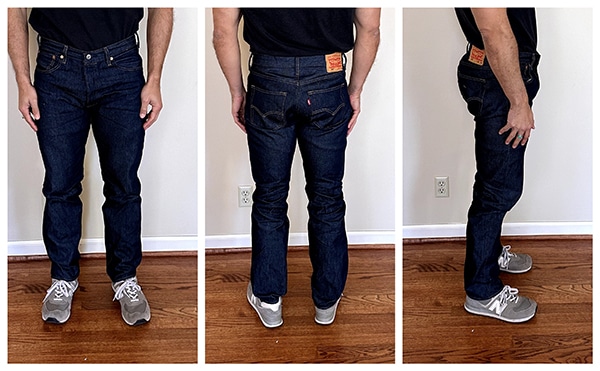
After
The waist fit fine, but I wasn’t happy with the inadequate shrinkage that occurred along the inseam, and especially around the knees, where there was a lot of bunching. Overall, the jeans still felt too baggy and loose.
Perhaps they’ll shrink more if I soak them again.
The tub-soaking method also left me with jeans that felt pretty stiff. That will likely work its way out as I wear them regularly.
One advantage to the old-school tub method is that your jeans will keep more of their classic indigo denim color than if you do the washing machine method.
Overall, I wasn’t happy with the result this process gave me. The fit was too off.
Washing Machine and Dryer Method
I then tried method two: throw your jeans in the washing machine on the cold cycle and then tumble dry.
For this method, I needed to buy 501s that were one inch bigger than my waist size and three inches bigger than my inseam.
So, for a 33×32 pant size, I needed to buy 501s that were 34×35. Levi’s didn’t offer a 501 with a 35-inch inseam, so I went with 34x34s. Even if they offered a 35-inch inseam, I think they would have been way too big even after shrinking.
Make sure you launder the jeans with other very dark colors, as they’ll release plenty of indigo color in the wash and blue fuzz in the dryer. I set the dryer on medium heat.
Here’s what the 34×34 jeans looked like before shrinking:
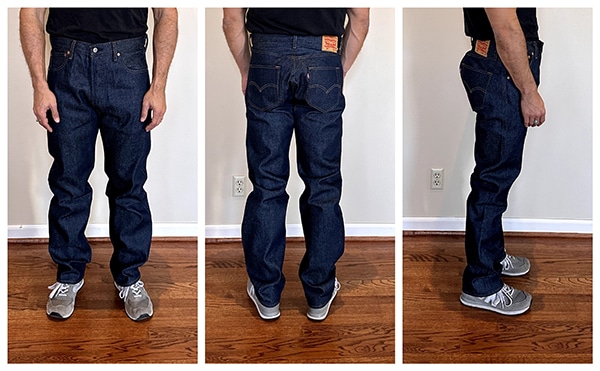
Before
As you can see, they’re pretty dang big. Really, really baggy. I didn’t think they’d be able to shrink enough to provide a decent fit.
After the first wash and tumble dry, the 34×34 jeans shrunk more than I’d expected but were still a tad too baggy. So I put them through the washer and dryer again (continued shrinkage can occur over the first several washings and dryings).
Here’s what they looked like after that second washing and drying:
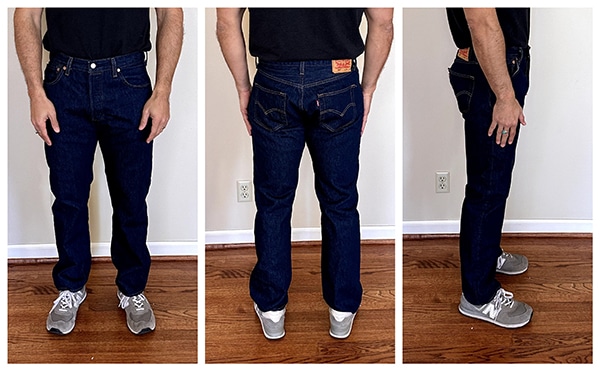
After
The waist fit perfectly. The inseam shrunk quite a bit. They’re a tad baggier than I like in jeans, but the overall fit was definitely better than the old-school method.
The other advantage of using the washer and dryer method is that the jeans feel less stiff and more broken-in than the ones treated with the old-school method.
Another thing you’ll notice with the washer/dryer method is that the color of your jeans will change to more of a royal blue. This is due to more indigo coming out of the fabric during the washing process. That could be a plus or minus, depending on your preference.
True-to-Fit, Shrink-to Fit-Jeans
I also tried buying a pair of 501s Shrink-to-Fit at my true-to-fit size.
Here’s what they look like:

Not too shabby. Again, a little baggier and bunchier in the knees than I think is ideal.
If you’re going to buy 501 Shrink-to-Fit Jeans with your true-to-fit size, you can’t ever wash them (yes, ever). They won’t fit you afterwards.
Which Levi’s 501 Shrink-to-Fit Method Should You Use?
I thought the washer and dryer method provided the best fit out of all the methods. Also, it was a heck of a lot easier.
I can see the appeal of the tub method. It’s like making French press coffee. It feels like you’re crafting your jeans. I also liked the resulting color of the old-school shrunk jeans over those that went through the washer. But based on my experience, the ROI wasn’t worth it.
Regardless of the method you use, you’ll want to wash your jeans minimally over the first year to allow your unique fades to set in the fabric. If you’re happy with your current fit and want to maintain it, let them air dry after washing (or dry on your body to allow the fabric to further conform to your physique). If you want more shrinkage (the jeans will stretch out as you wear them), put them in the dryer.
Would I Recommend Shrink-to-Fit Jeans?
After all the rigamarole I went through with fitting the 501 STFs, I’ve decided it’s a lot of work to get a pair of jeans that fit . . . okay. The fit will perhaps improve with some more washings and wearings, but I still don’t think it will be as good as pre-washed pairs I’ve bought off-the-rack.
I get the appeal of shrink-to-fit jeans. They give you a more custom-made look and feel. It’s nostalgic. There’s a romantic feeling that you’re taking part in a process that your grandpa went through to get a nice-fitting pair of jeans. 2009, 27-year-old retrosexual Brett would be all over this; 2024, 41-year-old Brett, not so much. I’ll take pre-washed and pre-shrunk jeans. They look good without the hassle.



